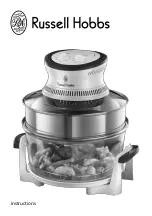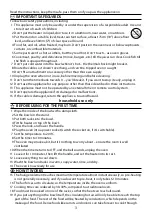
4
20 Even when roasted on a rack, hard vegetables can take a long time to cook through. We
recommend chopping/slicing, then parboiling in a pan, before putting them in the oven.
21 Tinned vegetables are pre-cooked, frozen vegetables are usually fresh-frozen.
22 You can use an ovenproof dish, casserole, or foil parcels, but rest them on a rack, and make
sure there’s room for air to circulate between the sides of the dish and the bowl.
23 Pasta, cereals, and beans should be cooked, or at least pre-cooked, before putting them in
the oven.
24 Light ingredients like herbs and spices laid on the surface of foods can be blown around by
the fan, so put them under other ingredients, or glue them done with oil or sauce.
25 Similarly, the surfaces of liquids like soups may be ruffled by the fan, so use a lidded casserole,
or cover loosely with foil.
C
FILLING
26 Put the stand on a stable, level, heat-resistant surface.
27 Sit the bowl on the stand.
28 Put one or both racks in the bowl.
29 Food on the top rack is closer to the element, so it might cook a bit faster, despite the effect
of the fan.
30 Food on the bottom rack will be in the shadow of any food on the top rack, so it might cook a
bit more slowly.
31 Food on both racks will need more heat to cook than food on one rack, so you might have to
extend the cooking time.
32 If you’re cooking something large, you might want to fit the extension on top of the bowl.
33 If you’re using the extension, you’ll need more heat, so you might have to extend the cooking
time even more.
32 Fit the heater on top of the bowl or extension.
C
COOKING
33 Press the lock, and lower the handle – the element won’t work if the handle isn’t flat down.
34 Plug the oven into a power socket (switch the socket on, if it’s switchable).
35 Set the temperature to whatever level you need.
36 Set the timer – moving the timer from 0 will turn the element on.
37 The
T
light will glow while the oven is on.
38 The
c
light will glow, then cycle on and off as the thermostat operates to maintain the
temperature.
39 Keep an eye on the cooking process – it’s much easier to see than with a conventional oven.
40 When the timer returns to 0, and the bell sounds, unplug the oven.
C
DONE?
41 Check the food is cooked. If you’re in any doubt, cook it a bit more.
,
Cook meat, poultry, and derivatives (mince, burgers, etc.) until the juices run clear. Cook fish
until the flesh is opaque throughout.
42 Use the oven gloves to lift the handle, and set the heater on its rest.
43 If you leave food in the oven after it’s cooked, excessive moisture may build up.
44 Use the rack tongs to lift the rack(s) out.
45 Meat will benefit from being allowed to rest before serving – cover with foil to keep it hot.
C
CARE AND MAINTENANCE
46 Unplug the oven.
47 Leave everything to cool down.
48 Wipe the heater surfaces with a damp cloth.
49 Wash the bowl and racks in warm, soapy water, rinse, and dry.








